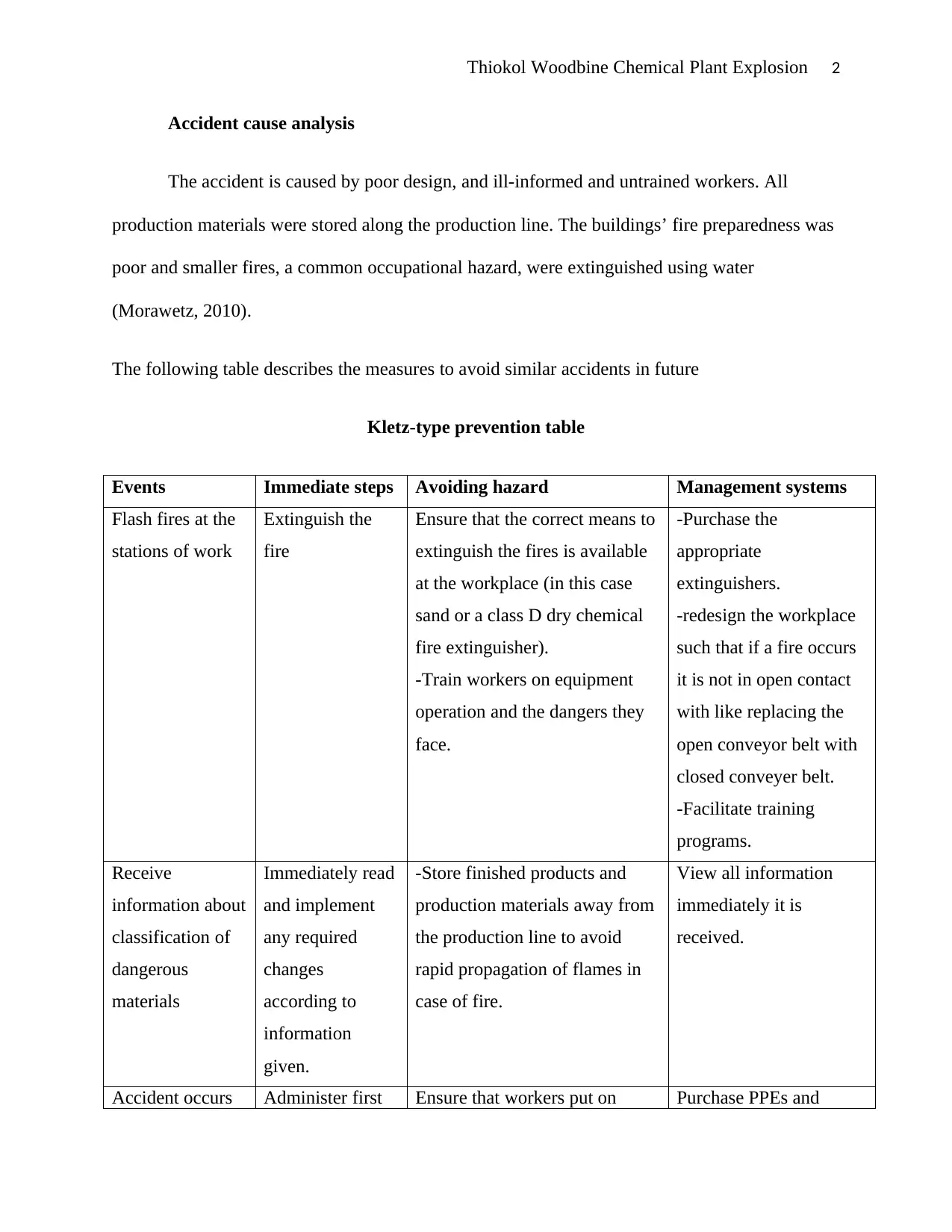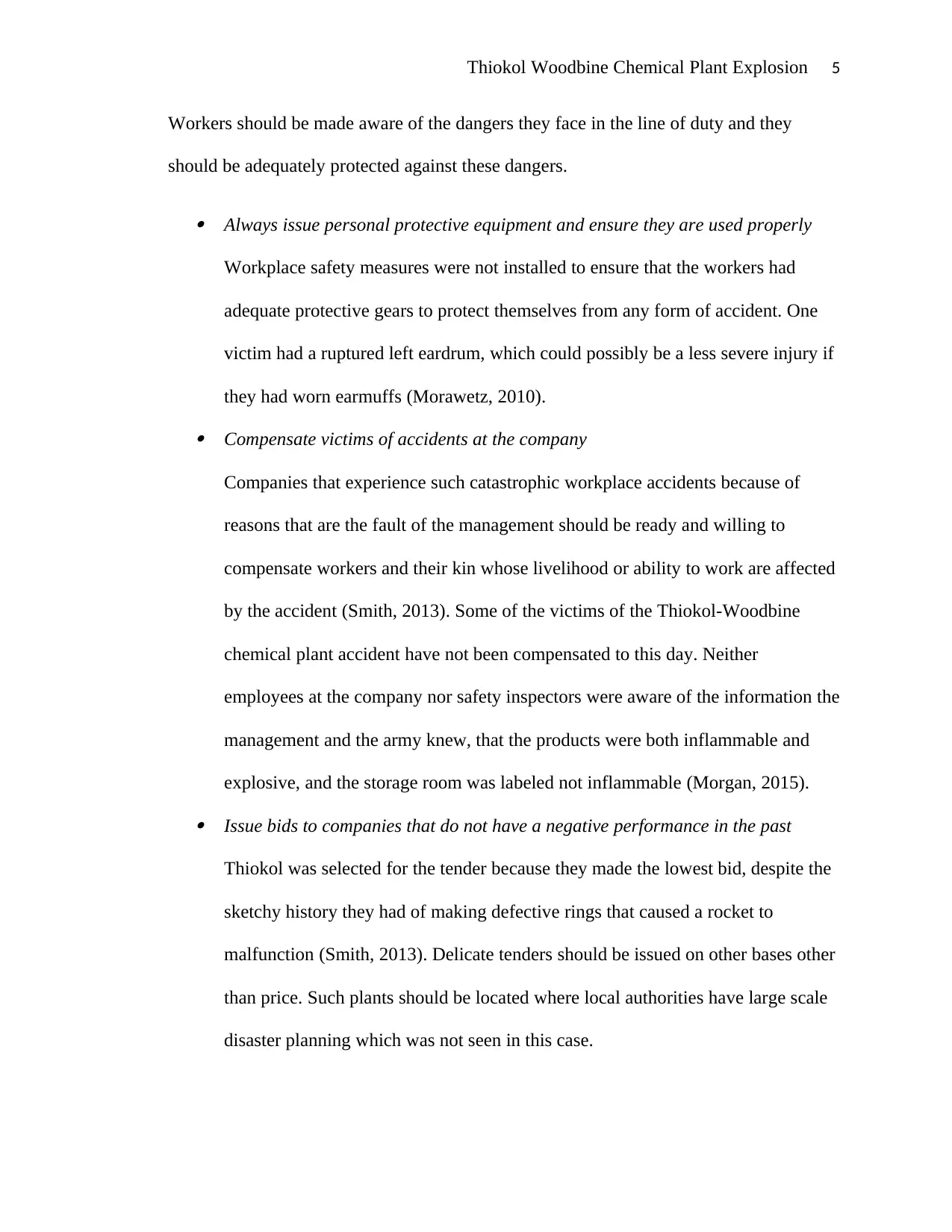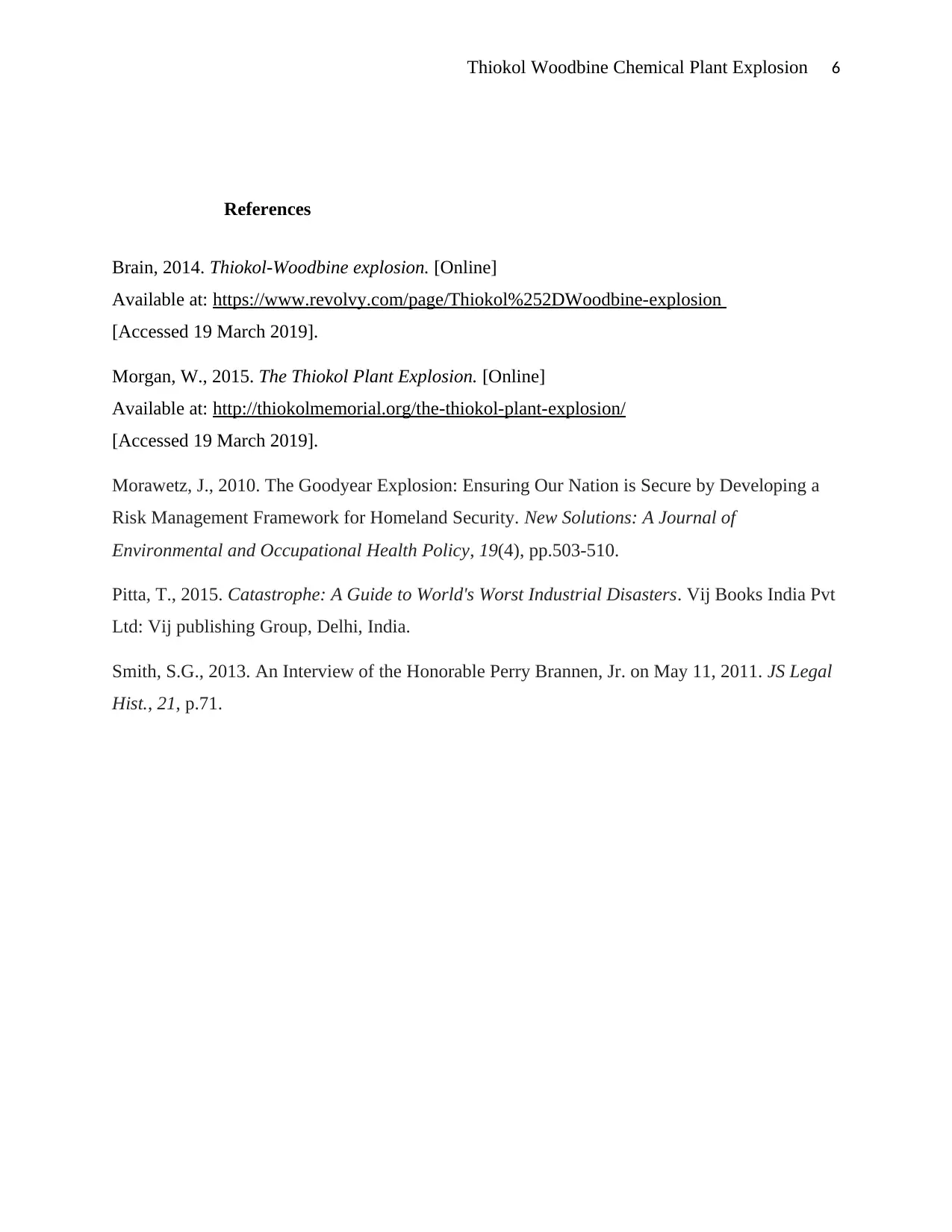Thiokol Woodbine Chemical Plant Explosion: Lessons Learned from a Devastating Industrial Accident
VerifiedAdded on 2023/04/25
|6
|1453
|165
AI Summary
In this report we will discuss about thiokol woodbine chemical plant explosion and below are the summaries point:-
Thiokol-Woodbine Chemical Plant explosion caused significant damage, including loss of life and destruction of buildings.
The accident was a result of poor design, lack of training, and inadequate fire preparedness measures.
Lessons learned include implementing proper hazard avoidance measures, improving management systems, and emphasizing accident preparedness and response.
Contribute Materials
Your contribution can guide someone’s learning journey. Share your
documents today.

Thiokol Woodbine Chemical Plant Explosion 1
Introduction
Thiokol-Woodbine was set up in 1969 to build solid propellant rocket motors for NASA
but later produced other items like fertilizer and flares for the army. The flares were to identify
enemy movements at night (Morgan, 2015). The classification of flares had been moved 3 years
prior from class 7 to class 2 in the order of most dangerous substances but was changed back on
October 29, 1972 (Morgan, 2015). This essay details lessons learnt from the evident mistakes
made in this chemical plant explosion.
How the Accident Happened
Magnesium, the main component, cannot be extinguished by water or carbon dioxide
(Smith, 2013). This together with sodium nitrate made up the illuminant pellet with a chemical
binder, while the ignition pellet constituted pyrotechnic substances (Brain, 2014). The fire began
at the station where an ignition element was being added to the other elements and spread to
other storage rooms in building M-132 and detonation occurred when components and flares
were ignited. The accident happened on 3rd February 1971 at 10:53a.m (Brain, 2014).
Extend of damage caused
Bodies were thrown 121.92 meters while debris was thrown 1300 meters from the
building. Moreover, 3 nearby buildings were destroyed, and a forest fire started which scorched
0.81km2 (Brain, 2014). Windows 18m away shattered and the explosion was heard within an
80km radius. Witnesses reported hearing three explosions, the first one sounding like a gunshot
and last like a bomb exploding. A total of 29 people died and 50 suffered injuries including
severed limbs (Brain, 2014).
Introduction
Thiokol-Woodbine was set up in 1969 to build solid propellant rocket motors for NASA
but later produced other items like fertilizer and flares for the army. The flares were to identify
enemy movements at night (Morgan, 2015). The classification of flares had been moved 3 years
prior from class 7 to class 2 in the order of most dangerous substances but was changed back on
October 29, 1972 (Morgan, 2015). This essay details lessons learnt from the evident mistakes
made in this chemical plant explosion.
How the Accident Happened
Magnesium, the main component, cannot be extinguished by water or carbon dioxide
(Smith, 2013). This together with sodium nitrate made up the illuminant pellet with a chemical
binder, while the ignition pellet constituted pyrotechnic substances (Brain, 2014). The fire began
at the station where an ignition element was being added to the other elements and spread to
other storage rooms in building M-132 and detonation occurred when components and flares
were ignited. The accident happened on 3rd February 1971 at 10:53a.m (Brain, 2014).
Extend of damage caused
Bodies were thrown 121.92 meters while debris was thrown 1300 meters from the
building. Moreover, 3 nearby buildings were destroyed, and a forest fire started which scorched
0.81km2 (Brain, 2014). Windows 18m away shattered and the explosion was heard within an
80km radius. Witnesses reported hearing three explosions, the first one sounding like a gunshot
and last like a bomb exploding. A total of 29 people died and 50 suffered injuries including
severed limbs (Brain, 2014).
Secure Best Marks with AI Grader
Need help grading? Try our AI Grader for instant feedback on your assignments.

Thiokol Woodbine Chemical Plant Explosion 2
Accident cause analysis
The accident is caused by poor design, and ill-informed and untrained workers. All
production materials were stored along the production line. The buildings’ fire preparedness was
poor and smaller fires, a common occupational hazard, were extinguished using water
(Morawetz, 2010).
The following table describes the measures to avoid similar accidents in future
Kletz-type prevention table
Events Immediate steps Avoiding hazard Management systems
Flash fires at the
stations of work
Extinguish the
fire
Ensure that the correct means to
extinguish the fires is available
at the workplace (in this case
sand or a class D dry chemical
fire extinguisher).
-Train workers on equipment
operation and the dangers they
face.
-Purchase the
appropriate
extinguishers.
-redesign the workplace
such that if a fire occurs
it is not in open contact
with like replacing the
open conveyor belt with
closed conveyer belt.
-Facilitate training
programs.
Receive
information about
classification of
dangerous
materials
Immediately read
and implement
any required
changes
according to
information
given.
-Store finished products and
production materials away from
the production line to avoid
rapid propagation of flames in
case of fire.
View all information
immediately it is
received.
Accident occurs Administer first Ensure that workers put on Purchase PPEs and
Accident cause analysis
The accident is caused by poor design, and ill-informed and untrained workers. All
production materials were stored along the production line. The buildings’ fire preparedness was
poor and smaller fires, a common occupational hazard, were extinguished using water
(Morawetz, 2010).
The following table describes the measures to avoid similar accidents in future
Kletz-type prevention table
Events Immediate steps Avoiding hazard Management systems
Flash fires at the
stations of work
Extinguish the
fire
Ensure that the correct means to
extinguish the fires is available
at the workplace (in this case
sand or a class D dry chemical
fire extinguisher).
-Train workers on equipment
operation and the dangers they
face.
-Purchase the
appropriate
extinguishers.
-redesign the workplace
such that if a fire occurs
it is not in open contact
with like replacing the
open conveyor belt with
closed conveyer belt.
-Facilitate training
programs.
Receive
information about
classification of
dangerous
materials
Immediately read
and implement
any required
changes
according to
information
given.
-Store finished products and
production materials away from
the production line to avoid
rapid propagation of flames in
case of fire.
View all information
immediately it is
received.
Accident occurs Administer first Ensure that workers put on Purchase PPEs and

Thiokol Woodbine Chemical Plant Explosion 3
resulting in
casualties who
were not wearing
protective gear.
aid and necessary
medical attention.
personal protective equipment
like helmets while at work for
safety measures.
ensure they are used.
Delayed response
to an accident due
to late detection
caused by lack of
installed
automatic
detectors of heat.
Extinguish the
fire.
Install heat or smoke detectors Emphasize more on
accident preparedness.
Recommendations
Lessons Learnt Educate workers on the dangers they face on duty
From this it is seen that educating workers on the nature of the materials they
handle is key to ensuring safety at the workplace. Every mishap at the workstation
should be taken seriously even if a temporary solution is found for it (Pitta, 2015).
Always treat correspondence from important with utmost urgency
Important correspondence should be treated with urgency so that no crucial news
is missed like in this instance where nobody at the plant knew that the flares
ranking on the dangerous materials index had changed because the letter stayed
unopened.
Always have measures in place in readiness for accidents
resulting in
casualties who
were not wearing
protective gear.
aid and necessary
medical attention.
personal protective equipment
like helmets while at work for
safety measures.
ensure they are used.
Delayed response
to an accident due
to late detection
caused by lack of
installed
automatic
detectors of heat.
Extinguish the
fire.
Install heat or smoke detectors Emphasize more on
accident preparedness.
Recommendations
Lessons Learnt Educate workers on the dangers they face on duty
From this it is seen that educating workers on the nature of the materials they
handle is key to ensuring safety at the workplace. Every mishap at the workstation
should be taken seriously even if a temporary solution is found for it (Pitta, 2015).
Always treat correspondence from important with utmost urgency
Important correspondence should be treated with urgency so that no crucial news
is missed like in this instance where nobody at the plant knew that the flares
ranking on the dangerous materials index had changed because the letter stayed
unopened.
Always have measures in place in readiness for accidents

Thiokol Woodbine Chemical Plant Explosion 4
Accident preparedness is necessary. Thiokol did not have the materials to help
contain the accident, protective clothing or a program to inform workers of the
dangers they faced in the line of duty (Morawetz, 2010). Every safety-conscious
plant should endeavor to have these provisions in place.
Note how materials are ranked on the dangerous materials index and treat them
appropriately as such
A Class 2 meant that the materials used in production were a fire hazard. They
should therefore have been appropriately labeled and stored away from the
production line which as reported was prone to small fire (Morawetz, 2010). The
hazardous material classification must be taken seriously.
Prevent occurrence of accidents by controlling release of energy
An open conveyor belt should not be used to move materials along the production
process if the materials are known to be flammable (Pitta, 2015). It puts the
employees in danger when an accident happens. A closed conveyor is safer.
Alter unsafe processes after accidents if production is to be resumed
After an accident, a chemical plant should at least attempt to change the
production process to a safer one. Thiokol-Woodbine simply resumed production
after the accident without even altering the prose, exposing workers to the same
risks (Brain, 2014).
Always respect principles of ergonomics
Principles of ergonomics must be followed at all chemical plants. Comfortable workers
perform better and are more careful in implementing their duties than ill-treated workers.
Accident preparedness is necessary. Thiokol did not have the materials to help
contain the accident, protective clothing or a program to inform workers of the
dangers they faced in the line of duty (Morawetz, 2010). Every safety-conscious
plant should endeavor to have these provisions in place.
Note how materials are ranked on the dangerous materials index and treat them
appropriately as such
A Class 2 meant that the materials used in production were a fire hazard. They
should therefore have been appropriately labeled and stored away from the
production line which as reported was prone to small fire (Morawetz, 2010). The
hazardous material classification must be taken seriously.
Prevent occurrence of accidents by controlling release of energy
An open conveyor belt should not be used to move materials along the production
process if the materials are known to be flammable (Pitta, 2015). It puts the
employees in danger when an accident happens. A closed conveyor is safer.
Alter unsafe processes after accidents if production is to be resumed
After an accident, a chemical plant should at least attempt to change the
production process to a safer one. Thiokol-Woodbine simply resumed production
after the accident without even altering the prose, exposing workers to the same
risks (Brain, 2014).
Always respect principles of ergonomics
Principles of ergonomics must be followed at all chemical plants. Comfortable workers
perform better and are more careful in implementing their duties than ill-treated workers.
Secure Best Marks with AI Grader
Need help grading? Try our AI Grader for instant feedback on your assignments.

Thiokol Woodbine Chemical Plant Explosion 5
Workers should be made aware of the dangers they face in the line of duty and they
should be adequately protected against these dangers. Always issue personal protective equipment and ensure they are used properly
Workplace safety measures were not installed to ensure that the workers had
adequate protective gears to protect themselves from any form of accident. One
victim had a ruptured left eardrum, which could possibly be a less severe injury if
they had worn earmuffs (Morawetz, 2010).
Compensate victims of accidents at the company
Companies that experience such catastrophic workplace accidents because of
reasons that are the fault of the management should be ready and willing to
compensate workers and their kin whose livelihood or ability to work are affected
by the accident (Smith, 2013). Some of the victims of the Thiokol-Woodbine
chemical plant accident have not been compensated to this day. Neither
employees at the company nor safety inspectors were aware of the information the
management and the army knew, that the products were both inflammable and
explosive, and the storage room was labeled not inflammable (Morgan, 2015).
Issue bids to companies that do not have a negative performance in the past
Thiokol was selected for the tender because they made the lowest bid, despite the
sketchy history they had of making defective rings that caused a rocket to
malfunction (Smith, 2013). Delicate tenders should be issued on other bases other
than price. Such plants should be located where local authorities have large scale
disaster planning which was not seen in this case.
Workers should be made aware of the dangers they face in the line of duty and they
should be adequately protected against these dangers. Always issue personal protective equipment and ensure they are used properly
Workplace safety measures were not installed to ensure that the workers had
adequate protective gears to protect themselves from any form of accident. One
victim had a ruptured left eardrum, which could possibly be a less severe injury if
they had worn earmuffs (Morawetz, 2010).
Compensate victims of accidents at the company
Companies that experience such catastrophic workplace accidents because of
reasons that are the fault of the management should be ready and willing to
compensate workers and their kin whose livelihood or ability to work are affected
by the accident (Smith, 2013). Some of the victims of the Thiokol-Woodbine
chemical plant accident have not been compensated to this day. Neither
employees at the company nor safety inspectors were aware of the information the
management and the army knew, that the products were both inflammable and
explosive, and the storage room was labeled not inflammable (Morgan, 2015).
Issue bids to companies that do not have a negative performance in the past
Thiokol was selected for the tender because they made the lowest bid, despite the
sketchy history they had of making defective rings that caused a rocket to
malfunction (Smith, 2013). Delicate tenders should be issued on other bases other
than price. Such plants should be located where local authorities have large scale
disaster planning which was not seen in this case.

Thiokol Woodbine Chemical Plant Explosion 6
References
Brain, 2014. Thiokol-Woodbine explosion. [Online]
Available at: https://www.revolvy.com/page/Thiokol%252DWoodbine-explosion
[Accessed 19 March 2019].
Morgan, W., 2015. The Thiokol Plant Explosion. [Online]
Available at: http://thiokolmemorial.org/the-thiokol-plant-explosion/
[Accessed 19 March 2019].
Morawetz, J., 2010. The Goodyear Explosion: Ensuring Our Nation is Secure by Developing a
Risk Management Framework for Homeland Security. New Solutions: A Journal of
Environmental and Occupational Health Policy, 19(4), pp.503-510.
Pitta, T., 2015. Catastrophe: A Guide to World's Worst Industrial Disasters. Vij Books India Pvt
Ltd: Vij publishing Group, Delhi, India.
Smith, S.G., 2013. An Interview of the Honorable Perry Brannen, Jr. on May 11, 2011. JS Legal
Hist., 21, p.71.
References
Brain, 2014. Thiokol-Woodbine explosion. [Online]
Available at: https://www.revolvy.com/page/Thiokol%252DWoodbine-explosion
[Accessed 19 March 2019].
Morgan, W., 2015. The Thiokol Plant Explosion. [Online]
Available at: http://thiokolmemorial.org/the-thiokol-plant-explosion/
[Accessed 19 March 2019].
Morawetz, J., 2010. The Goodyear Explosion: Ensuring Our Nation is Secure by Developing a
Risk Management Framework for Homeland Security. New Solutions: A Journal of
Environmental and Occupational Health Policy, 19(4), pp.503-510.
Pitta, T., 2015. Catastrophe: A Guide to World's Worst Industrial Disasters. Vij Books India Pvt
Ltd: Vij publishing Group, Delhi, India.
Smith, S.G., 2013. An Interview of the Honorable Perry Brannen, Jr. on May 11, 2011. JS Legal
Hist., 21, p.71.
1 out of 6
Your All-in-One AI-Powered Toolkit for Academic Success.
+13062052269
info@desklib.com
Available 24*7 on WhatsApp / Email
![[object Object]](/_next/static/media/star-bottom.7253800d.svg)
Unlock your academic potential
© 2024 | Zucol Services PVT LTD | All rights reserved.